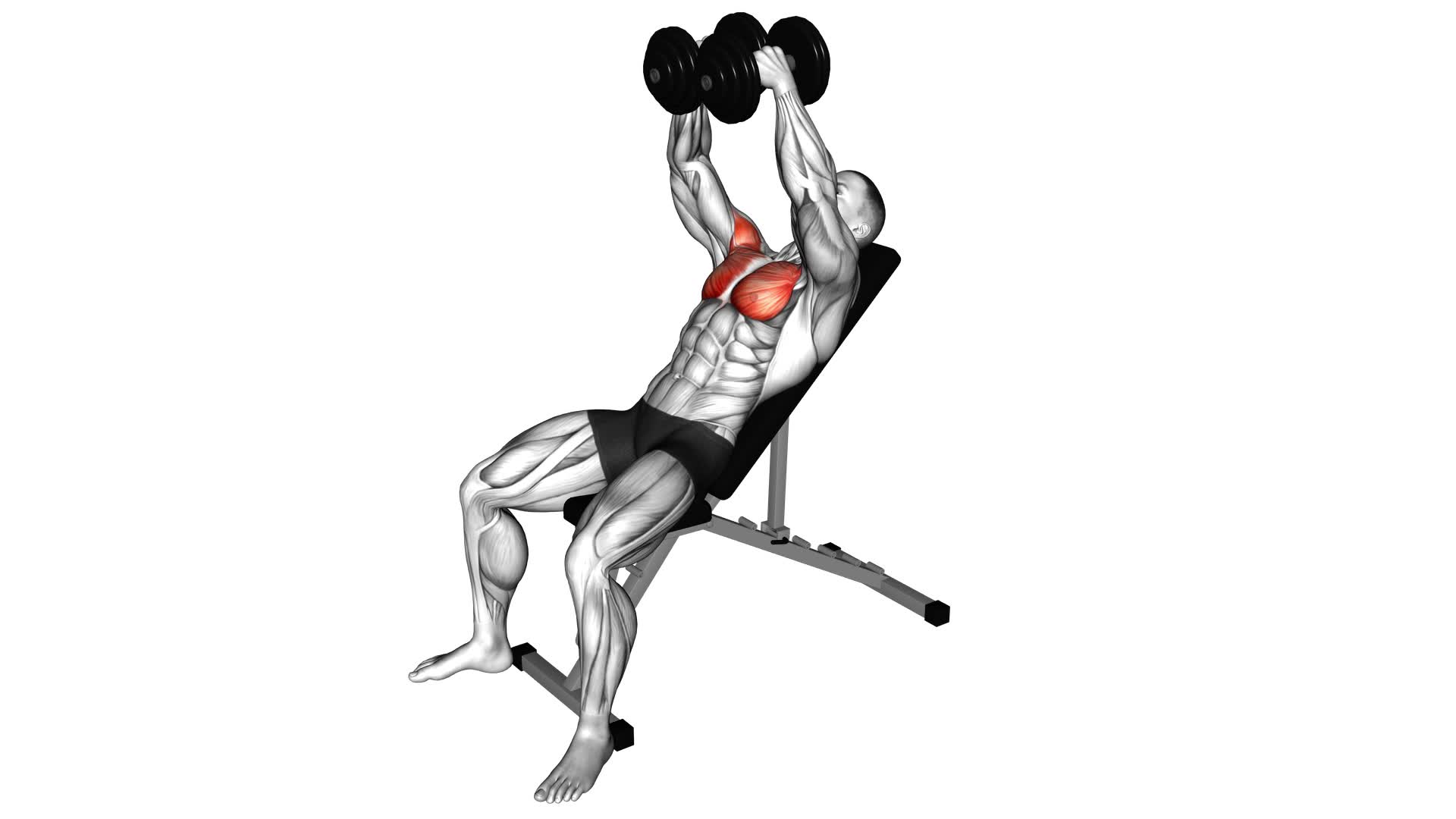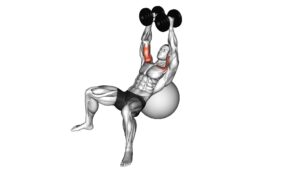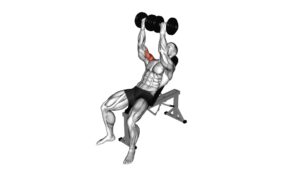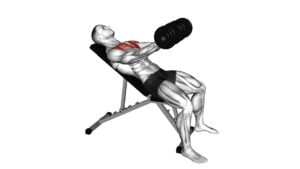Dumbbell Incline Fly – Video Exercise Guide & Tips

Get ready to sculpt your chest with the dumbbell incline fly! This video exercise guide and tips will show you the proper form and help you choose the right weight for your fitness level.
Watch This Exercise Video
Maximize chest engagement and avoid common mistakes with expert advice. Plus, discover variations and progressions to keep challenging yourself.
Grab your dumbbells and let's get started!
Key Takeaways
- Proper form and technique are essential for performing dumbbell incline fly correctly and effectively.
- Choosing the right weight is important to ensure proper form and gradually increase the challenge as strength improves.
- Variations and progressions can be incorporated to add variety and challenge to the exercise.
- Resistance bands can be used to increase muscle activation and engagement during dumbbell incline fly exercises.
Proper Form for Dumbbell Incline Fly
To perform the dumbbell incline fly exercise with proper form, you should position yourself on an incline bench and hold the dumbbells with a pronated grip.
This exercise is great for targeting the upper chest and maximizing results. Start by lying on the incline bench, ensuring that your head, shoulders, and back are firmly supported. Keep your feet flat on the ground for stability.
Hold the dumbbells with your palms facing each other and your arms fully extended above your chest. Slowly lower the dumbbells in a controlled manner, allowing your elbows to bend slightly. Maintain a slight bend in your elbows throughout the movement.
As you lower the dumbbells, feel the stretch in your chest muscles. Pause for a moment and then return to the starting position by squeezing your chest muscles and pushing the dumbbells back up. Remember to breathe throughout the exercise and maintain a smooth and controlled motion.
Now that you know the proper form for the dumbbell incline fly, let's move on to choosing the right weight for your fitness level.
Choosing the Right Weight for Your Fitness Level
Now that you understand the proper form for the dumbbell incline fly exercise, let's focus on selecting the appropriate weight based on your fitness level. Choosing the right weight is crucial for maximizing the effectiveness of the exercise and preventing injury.
When it comes to selecting the weight for the dumbbell incline fly, it's important to start with a weight that challenges you but still allows you to maintain proper form throughout the exercise. As a general guideline, beginners should start with lighter weights and gradually increase the weight as they become stronger and more comfortable with the exercise.
To determine the recommended weight for your fitness level, it's helpful to consider your current strength and endurance. If you're able to complete 10-12 repetitions with ease, it's time to increase the weight. On the other hand, if you're struggling to complete the repetitions, it may be a sign that the weight is too heavy.
Progression options for the dumbbell incline fly include increasing the weight, increasing the number of sets or repetitions, or adding variations such as incline push-ups. These options allow you to continuously challenge your muscles and make progress in your fitness journey.
In the next section, we'll discuss some tips for maximizing chest engagement during the dumbbell incline fly exercise. By following these tips, you can ensure that you're targeting the right muscles and getting the most out of your workout.
Tips for Maximizing Chest Engagement
To maximize chest engagement during the dumbbell incline fly exercise, focus on maintaining proper form and activating the muscles in your chest throughout the entire movement. Here are some tips to help you maximize your chest activation and incorporate the incline fly into your workout routine:
- Maintain a controlled movement: Slowly lower the dumbbells out to the sides, keeping your elbows slightly bent. This controlled movement ensures that your chest muscles are engaged throughout the exercise.
- Squeeze your chest: At the top of the movement, when your arms are extended out to the sides, squeeze your chest muscles. This contraction will help to activate and strengthen your chest.
- Incorporate a full range of motion: Lower the dumbbells until you feel a stretch in your chest muscles, then bring the weights back up, maintaining tension on your chest throughout. This full range of motion will help to fully engage your chest muscles.
- Focus on mind-muscle connection: Concentrate on feeling your chest muscles working during the exercise. Visualize them contracting and releasing with each repetition. This mind-muscle connection can enhance your chest activation and overall effectiveness of the exercise.
Common Mistakes to Avoid During the Exercise
To avoid compromising your form and minimizing the effectiveness of the dumbbell incline fly exercise, it's important to be aware of common mistakes and take steps to avoid them.
One common mistake to avoid is using too much weight. It may be tempting to lift heavy, but using weights that are too heavy can put unnecessary strain on your muscles and increase the risk of injury. It's crucial to choose a weight that allows you to maintain proper form throughout the exercise.
Another mistake to avoid is improper breathing technique. Many people tend to hold their breath during the exercise, which can lead to increased blood pressure and decreased oxygen supply to the muscles. To avoid this, remember to exhale as you lift the dumbbells and inhale as you lower them. This will ensure that you're supplying your muscles with the necessary oxygen and also help stabilize your core.
Lastly, it's important to avoid using momentum to perform the exercise. Swinging the weights or using a jerking motion can take the focus away from your chest muscles and put strain on other parts of your body, such as your shoulders or lower back. Instead, focus on maintaining a controlled and steady movement throughout the exercise, emphasizing the contraction of your chest muscles.
Variations and Progressions to Keep Challenging Yourself
To keep challenging yourself, you can explore various variations and progressions of the dumbbell incline fly exercise. Here are some advanced modifications and ways to incorporate resistance bands into your routine:
- Variations:
- Single-Arm Incline Fly: Perform the exercise with one arm at a time, focusing on maintaining balance and stability.
- Alternating Incline Fly: Alternate between left and right arms during each repetition to engage both sides of your chest evenly.
- Progressions:
- Incline Fly with Increased Weight: Gradually increase the weight of the dumbbells as you gain strength and feel comfortable with the exercise.
- Incline Fly with Isometric Holds: Hold the weights at the peak of the movement for a few seconds before lowering them back down. This adds an extra challenge to your chest muscles.
- Incorporating Resistance Bands:
- Resistance Band Incline Fly: Attach resistance bands to the handles of the dumbbells and perform the exercise as usual. The bands will provide additional resistance throughout the movement.
- Resistance Band Fly with External Rotation: Loop the resistance band around your wrists and perform the incline fly exercise with external rotation at the top. This targets your chest and shoulders simultaneously.
Frequently Asked Questions
How Many Sets and Reps Should I Do for the Dumbbell Incline Fly Exercise?
To determine the number of sets and reps for the dumbbell incline fly exercise, it's important to consider your fitness goals and current fitness level. Different variations of this exercise can target different muscle groups and vary in intensity.
Incorporating the dumbbell incline fly into your workout routine can help strengthen your chest, shoulders, and arms. It's always best to consult with a fitness professional to create a personalized plan that suits your needs and abilities.
Can I Perform the Dumbbell Incline Fly Exercise With a Flat Bench Instead of an Incline Bench?
Yes, you can perform the dumbbell incline fly exercise with a flat bench instead of an incline bench. However, using an incline bench helps target the upper chest muscles more effectively.
If you don't have access to an incline bench, you can try alternative exercises like the flat bench fly or the push-up. These exercises also work the chest muscles and can provide a good workout.
Is It Better to Perform the Dumbbell Incline Fly Exercise With a Neutral Grip or a Pronated Grip?
For the dumbbell incline fly exercise, is it better to use a neutral grip or a pronated grip?
The choice between the two grips depends on your specific goals and preferences.
A neutral grip targets the chest muscles more, while a pronated grip engages the shoulders and triceps.
Both grips have their advantages and disadvantages, so it's important to experiment and see which grip feels more comfortable and effective for you.
Can I Substitute the Dumbbell Incline Fly Exercise With a Machine Fly Exercise?
Yes, you can substitute the dumbbell incline fly exercise with a machine fly exercise. Using machines for chest exercises has several benefits.
Machines provide stability and support, making it easier to maintain proper form. They also allow for a greater range of motion and can target specific muscles effectively.
To perform the machine fly exercise, adjust the seat and handles to your desired position. Sit with your back against the pad and smoothly bring your arms together in front of you, squeezing your chest muscles.
What Are Some Alternative Exercises That Target the Same Muscle Groups as the Dumbbell Incline Fly?
There are several alternative exercises that target the same muscle groups as the dumbbell incline fly. Some variations of the dumbbell incline fly include the cable fly, pec deck fly, and the machine fly. These exercises also work the chest muscles, specifically the pectoralis major and minor.
Incline exercises, like the dumbbell incline fly, help to target the upper chest and improve overall chest development. To perform the dumbbell incline fly correctly, lie on an incline bench with a dumbbell in each hand, then lower your arms out to the sides and bring them back up in a controlled manner.
Conclusion
In conclusion, the dumbbell incline fly is an effective exercise for targeting and engaging the chest muscles.
By maintaining proper form, choosing the appropriate weight, and following the tips provided, you can maximize the benefits of this exercise.
It's important to avoid common mistakes and continue challenging yourself with variations and progressions to continually improve your chest strength and definition.

Author
Years ago, the spark of my life’s passion ignited in my mind the moment I stepped into the local gym for the first time. The inaugural bead of perspiration, the initial endeavor, the very first surge of endorphins, and a sense of pride that washed over me post-workout marked the beginning of my deep-seated interest in strength sports, fitness, and sports nutrition. This very curiosity blossomed rapidly into a profound fascination, propelling me to earn a Master’s degree in Physical Education from the Academy of Physical Education in Krakow, followed by a Sports Manager diploma from the Jagiellonian University. My journey of growth led me to gain more specialized qualifications, such as being a certified personal trainer with a focus on sports dietetics, a lifeguard, and an instructor for wellness and corrective gymnastics. Theoretical knowledge paired seamlessly with practical experience, reinforcing my belief that the transformation of individuals under my guidance was also a reflection of my personal growth. This belief holds true even today. Each day, I strive to push the boundaries and explore new realms. These realms gently elevate me to greater heights. The unique combination of passion for my field and the continuous quest for growth fuels my drive to break new ground.







